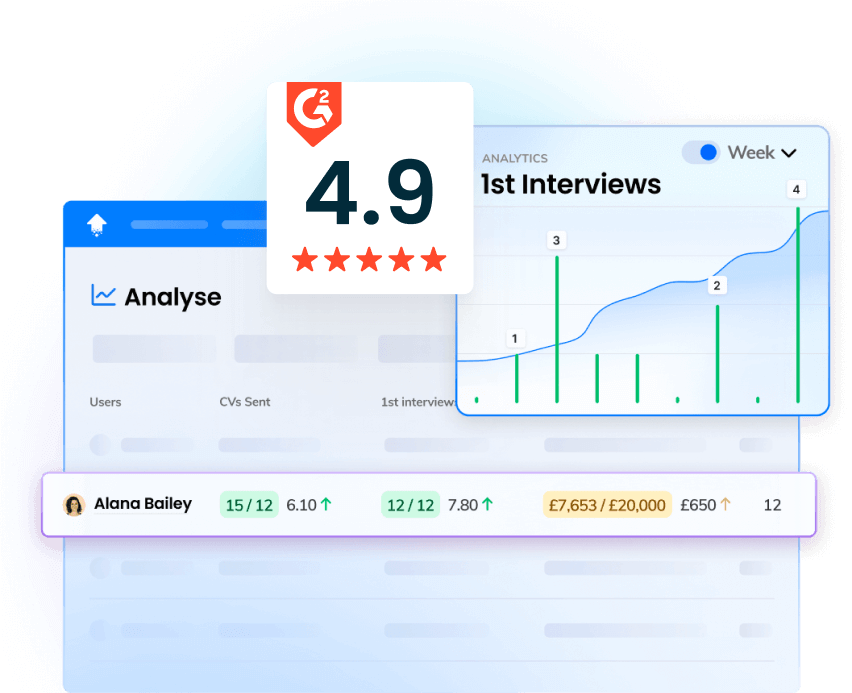Cost per hire is a vital recruitment metric that measures the total expenditure required to fill a job vacancy.
For recruitment agencies, cost per hire is critical as it reflects the efficiency and effectiveness of their hiring processes, which allows them to identify inefficiencies, optimise spending, and improve overall recruitment strategies.
Indeed, by understanding the breakdown of costs, agencies can make informed decisions about resource allocation, target areas for improvement, and negotiate better terms with vendors or clients.
A detailed cost-per-hire analysis not only helps when it comes to maintaining profitability but also enhances client satisfaction by ensuring quality hires are delivered within budget.
Ultimately, tracking and managing cost per hire supports better planning, reduces waste, and strengthens the agency’s competitive edge in a highly demanding recruitment market.
What is Cost per Hire?
To begin with, we’ll delve into what exactly cost per hire means, covering the different components of this metric.
Cost per Hire Definition
In the context of a recruitment agency, cost per hire refers to the total expenses involved in sourcing and placing a candidate with a client.
It includes both internal and external costs.
By tracking this metric, recruitment agencies can evaluate the efficiency of their processes, optimise their spending, and enhance profitability while ensuring the delivery of quality candidates to clients.
Why is Cost per Hire Important?
Cost per hire is crucial for recruitment agencies as it helps assess the efficiency and effectiveness of their hiring processes.
By tracking this metric, agencies can optimise their resources, reduce unnecessary spending, and improve the quality of candidates they place.
After all, a lower cost per hire can enhance profitability and provide a competitive edge.
Additionally, cost-per-hire metrics are directly related to overall recruitment ROI, as they reflect how well the agency manages recruitment costs relative to the value generated for clients.
By improving cost per hire, agencies can increase their profitability and client satisfaction, ultimately driving better returns on their recruitment efforts.
Components of Cost per Hire
Tracking cost per hire is not as straightforward as it seems.
Sure, you know you need to track your big budget spending like salaries, commission, and the cost of your CRM, but what about all the smaller costs that go into the recruitment process, like subscriptions to job boards or even candidate ghosting?
Here’s a breakdown of the costs you need to think about.
Internal Costs
Your internal costs are the costs you naturally incur within your recruitment agency, rather than those paid to third parties.
- Recruiter salaries: Wages paid to in-house recruitment staff.
- Employee benefits: Benefits provided to internal recruitment team members, such as pensions and insurance.
- Recruiter commissions and incentives: Any bonuses or incentives tied to the recruitment project.
- Training and development costs: Expenses for upskilling recruitment staff.
- Recruitment team expenses: Expenses for travel, accommodation and food where relevant.
- Office space and utilities: Proportional costs for facilities used by recruitment staff.
- Internal marketing costs: Expenditure on branding and promoting the agency to attract candidates.
- Administrative costs: Expenses for support staff, paperwork, and compliance-related activities.
External Costs
Your external costs are the fees you pay to third parties for tools, services, tech subscriptions, and more.
- Job advertising: Costs for posting vacancies on job boards, social media, or print media.
- Recruitment agency fees: Payments to external agencies for sourcing candidates, where applicable.
- Marketing agency fees: Payments to external agencies for marketing and employer branding, where applicable.
- Background checks: Costs for conducting pre-employment checks, such as criminal records or reference verifications.
- Candidate assessment tools: Fees for external tests or assessment platforms used during hiring.
- Event participation: Costs for attending or hosting job fairs, recruitment events, or networking sessions.
- Technology subscriptions: Payments for external platforms like ATS, CRM, LinkedIn Recruiter or other tools.
- Third-party services: Costs for outsourcing tasks like CV screening or psychometric testing.
- Relocation expenses: Contributions towards relocating candidates, if applicable.
Hidden Costs
Of course, there are plenty of hidden costs associated with running a recruitment agency.
Here are some of the most common.
- Time-to-fill delays: Lost productivity or revenue due to unfilled positions.
- Candidate ghosting: Costs of candidates withdrawing after significant investment in their recruitment.
- Employee turnover: Expenses incurred from replacing hires who leave shortly after joining.
- Inefficient processes: Hidden costs from outdated or ineffective recruitment workflows.
- Poor-quality hires: Long-term costs of underperforming new employees placed with clients.
- Recruiter burnout: Decreased productivity and potential turnover among overworked recruitment staff.
- Compliance issues: Fines or penalties for failing to meet legal recruitment requirements.
- Missed opportunities: Potential clients or candidates lost due to suboptimal branding or outreach.
- Training for new hires: Extra onboarding costs for poorly prepared candidates.
- Client dissatisfaction: Costs of losing clients due to mismatched or low-quality placements.
How to Calculate Cost per Hire
So, we’ve established that keeping track of your average cost per hire is paramount.
But how exactly do you calculate it?
Cost per Hire Formula
The cost-per-hire formula is pretty simple.
It looks like this:
(Total Internal Costs + Total External Costs) ÷ Total Hires
To get the end result, add up the recruitment-related expenses outlined above and divide the total by the number of hires made during a specific period.
Cost Per Hire Calculation Example
Of course, when you consider all the expenses you need to include, calculating cost per hire becomes a little trickier.
To help you visualise the process, here’s a real-world cost per hire example.
Suppose a recruitment agency has successfully placed 50 candidates with clients over six months.
During that time, the agency has racked up the following expenses:
- Internal recruiter salaries: £200,000
- Job board advertising: £15,000
- Recruitment software subscriptions: £12,000
- Office overheads: £8,000
- External candidate assessments: £5,000
- Marketing and branding campaigns: £10,000
Add up these expenses, and their total recruitment costs come to £250,000.
Now, it’s time to calculate their cost per hire.
(Total Internal Costs + Total External Costs) ÷ Total Hires
£250,000 ÷ 50
Cost per hire = £5,000
The agency’s cost per hire is £5,000.
If they want to reduce this cost, they could focus on optimising advertising spend, improving internal workflows, or negotiating better terms with external suppliers.
Step-by-Step Guide to Analysing Cost Per Hire
Let’s break it down even further and look at how to analyse your average cost per hire in five steps.
Step 1: Gather Data
Start with a data audit to ensure that all the data surrounding your recruitment costs is accurate, consistent and relevant.
Step 2: Categorise Costs
Next, you’ll need to break down your costs by channel, campaign, hire, and any other relevant categories.
While you’ve added all your costs up to work out your cost-per-hire, it’s important to categorise in order to properly analyse this metric.
This will help you to identify specific areas of expenditure and pinpoint inefficiencies, optimise budget allocation, and ensure accurate analysis.
It enables agencies to improve decision-making, reduce unnecessary costs, and enhance overall recruitment efficiency and profitability.
Step 3: Identify High-Cost Areas
Now it’s time to start identifying your high-cost areas, using your pipeline insights.
Drill down into the data to discover bottlenecks, identify trends, and find out which activities are costing you more than they should be.
Step 4: Benchmark Against Industry Standards
Of course, it’s hard to know exactly what every activity should be costing you without a benchmarking exercise.
Compare your costs to the most recent industry averages you can find, for example the average cost per hire 2024.
Where possible, you will want to compare your figures against the average recruiting cost per hire within agencies that cater to similar clients, are in a similar niche and are of a similar size.
Step 5: Optimise Recruitment Spending
It’s time to take action!
Based on what you’ve learned in your cost-per-hire analysis and your cost-per-hire benchmark exercise, create a strategy that will optimise your recruitment spending.
Consider where costs could be cut without impacting your service, and adjust your strategies to focus on channels that are delivering high ROI.
Challenges in Cost per Hire Analysis
Accurately measuring cost per hire involves tracking numerous agency costs, which presents several challenges.
Avoid these three major pitfalls to ensure an effective cost-per-hire analysis.
#1 Data Accuracy
Real-time, accurate data is essential when calculating cost per hire.
Data accuracy ensures precise insights into recruitment spending and ensures you’re not making important decisions based on unreliable information.
Real-time data is critical to data accuracy, too.
After all, data that was accurate last week, yesterday, or even this morning may not be representative this afternoon.
Having access to real-time data helps identify inefficiencies, monitor budget adherence, and respond quickly to changing recruitment needs.
What’s more, accurate tracking allows agencies to optimise processes, justify costs to clients, and improve decision-making, ultimately enhancing profitability and ensuring a competitive edge in the recruitment market.
#2 Tracking Hidden Costs
Tracking indirect expenses and hidden costs is vital when calculating cost per hire to gain a comprehensive understanding of recruitment expenditures.
As every recruitment leader knows, overlooked costs, such as time-to-hire delays, recruiter burnout, or poor-quality hires, can significantly impact profitability and efficiency.
By accounting for these, organisations can identify inefficiencies, improve hiring strategies, and allocate resources effectively.
Failing to track hidden costs, meanwhile, may lead to underestimated budgets, reduced ROI, and missed opportunities to optimise recruitment processes — essentially, your data won’t be accurate.
#3 Interpreting Results
Now, you need to interpret your cost-per-hire results, gleaning valuable insights and using them to drive your recruitment team to success.
Here are five key strategies for analysing your results and turning them into action.
- Identify inefficiencies: Use cost data to pinpoint areas of overspending or delays in the hiring process.
- Optimise resource allocation: Allocate budgets to the most cost-effective channels and tools.
- Enhance processes: Streamline workflows to reduce unnecessary expenses and improve time-to-hire.
- Set internal benchmarks: Compare cost per hire across roles or time frames to establish performance standards.
- Justify investments: Leverage insights to advocate for better tools, training, or staff resources.
Best Practices for Cost per Hire Optimisation
To help ensure your cost-per-hire analysis is successful, follow these three best practices.
#1 Regularly Review Cost-Per-Hire Metrics
Calculating and analysing your cost-per-hire metric is not a one-time thing.
As your agency evolves, the market shifts, and clients come and go, your cost per hire will fluctuate.
It’s vital to set up a process for regularly reviewing this metric in order to stay agile and efficient.
It will help you to consistently identify trends, track performance, and spot areas for improvement.
The result?
You can continuously optimise your spending and strategies to remain competitive while delivering value to clients.
#2 Leverage Automation to Reduce Manual Tasks

Automation improves accuracy, saves time, and minimises human error.
In 2025, it’s indispensable.
Just imagine how long it would take to manually track cost-per-hire continuously!
Fortunately, with OneUp, you can streamline real-time performance data collection and automate reports.
This enables lightning-speed insights, better resource allocation, and more efficient decision-making, reducing costs and enhancing recruitment performance.
#3 Focus on Candidate Experience to Lower Time-To-Fill Costs
A positive, streamlined candidate experience encourages quicker decision-making from candidates and reduces delays in the hiring process.
By enhancing communication, providing clear expectations, and offering feedback, agencies can speed up the hiring cycle, reduce drop-offs and lower recruitment costs while improving client satisfaction and strengthening their employer brand.
This, in turn, lowers your cost per hire.
Conclusion: Maximising ROI in Recruitment
Understanding and optimising cost per hire is essential for recruitment agencies to improve efficiency, reduce unnecessary spending, and maximise profitability.
By tracking this metric, agencies can identify and swiftly tackle inefficiencies, allocate resources effectively, and refine recruitment strategies.
Not only does this drive down costs and boost ROI, but it also helps you deliver better results to clients — all while maintaining cost-effective operations.
As outlined above, investing in the right tech stack for your agency is crucial for accurately and efficiently tracking and analysing cost per hire.
OneUp’s reports show users real-time performance results whenever they need them. Find out more by booking a demo today.




